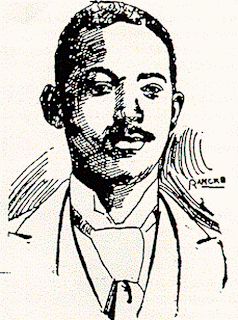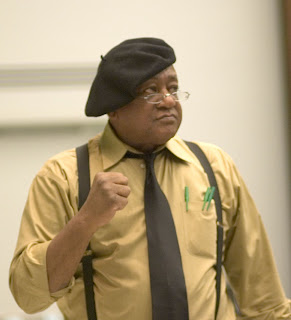“Sugarcoated Arsenic.” Film Explores African-American Life at University of Virginia in the 1970s
MARCH 11, 2013 ROBERT HULL. Students, faculty and other members of the University community filled the South Lawn Auditorium at Nau Hall Thursday to watch a black-and-white film, “Sugarcoated Arsenic.” In slightly more than 20 minutes, the film tells a remarkable story of African-American intellectual, social and political life at the University of Virginia in the 1970s.
“Sugarcoated Arsenic” was co-created by two College of Arts & Sciences faculty members, filmmaker Kevin Jerome Everson, a professor in the McIntire Department of Art, and Claudrena Harold, an associate professor in the Corcoran Department of History and the Carter G. Woodson Institute for African-American and African Studies. The film conveys its message through the words and legacy of the late Vivian Verdell Gordon, director of U.Va.’s black studies program between 1975 and 1980.
The short film stars Erin Stewart, a professional actress and graduate of the U.Va. Department of Drama, as Gordon in re-enacted documentary-style footage, and utilizes an audiotape of a speech Gordon gave in 1984 at an event sponsored by the Office of African-American Affairs at the Luther P. Jackson House.
“Vivian Gordon was very much loved,” Harold said. “I think it’s safe to say that there’s never been a professor who enjoyed the kind of popularity that she had among black students.”
In more than 70 shorts and five feature-length films, Everson has often used a faux documentary technique in his award-winning work. Archival footage is re-edited or re-staged, real people perform re-enactments and historical moments interweave with contemporary narrative.
Shot on 16mm film, “Sugarcoated Arsenic” – the title is drawn from a phrase in Gordon’s taped speech – unfolds as if it were archival footage being discovered at the moment of viewing.
“It looks like the cans of film that Claudrena would find – that we, in fact, did not find – in searching through the archives,” Everson said. “It’s as if she had been in the archives somewhere, and she’d see these cans of film. For me, that’s what the film is – that’s part of the art object.”
Shot during the advent of Superstorm Sandy at the end of October, the film was made quickly and on the fly. Prior to the shoot, students were fitted for ’70s-style clothing and given hairstyles to match the era. The key was to avoid making the footage look like a fashion shoot or a nostalgia piece.
“We had the audiotape of Gordon,” Everson said, “but all the footage you see is based on photographs that were taken of African-American students here at the University in the ’70s. We just re-enacted the photographs.”
Everson and Harold applied for the Arts in Action grant in October 2011 to do a project on the history of African-Americans at U.Va. during the 1960s and the ’70s.
“It’s been 12 months of work, 12 months of digging, 12 months of discovering and 12 months of questioning,” Harold said.
“Sugarcoated Arsenic” is part of a multimedia initiative, “Black Fire,” sponsored by U.Va.’s Office of the Vice Provost for the Arts and funded by an Arts in Action grant. Featuring film, photography, lectures, performance art, a public exhibit and an online resource center, the “Black Fire” project explores the complex history of the struggle for racial equality, social justice and cultural transformation at the University between 1969 and 1985.
The project includes a wide range of research and artistic activities, including extensive interviews with former African-American faculty and alumni, as well as digitizing the files of the Black Student Alliance.
“My vision was to tell the story of African-American studies at U.Va, along with the struggle not just to integrate this place, but to transform it,” Harold said. “And I wanted to tell the story using Kevin’s aesthetic.”
As the film project progressed, Harold searched various archival collections, hoping to find footage of African-American students on Grounds at U.Va. during this key period of activism. But nothing turned up.
As an experimental filmmaker working in the space between fact and fiction, Everson’s style is to interrupt the documentary impulse by creating supposedly found archival documents. His established techniques dovetailed with the turn of events.
“Well, I thought, why don’t we just make a film as if Claudrena Harold – with all her effort, time and passion looking through the archives – had found this footage,” Everson said. “So the whole strategy was to shoot a film as if somebody shot it here at U.Va. in 1976.”
Based on the enthusiastic response to Thursday’s premiere, the strategy worked. With Gordon at the center, the film captures a vibrant community of African-American students and faculty connected by intellectual curiosity and human warmth.
Throughout the ’70s, there were numerous marches by African-American students to Carr’s Hill, including one in 1971. Inspired by these peaceful protests, the film depicts a staged protest using current U.Va. African-American students in the roles of their forerunners.
Harold was interested in seeing how current students would access the spirit of the original protest. “One of the most interesting moments that we had in the film was when the students were marching, and they had to sing,” she said.
Everson’s footage shows that the students are truly emotionally involved in the experience, touched by their own united voices as they march and sing together in re-enacted protest.
“And I told them,” Harold said, “that if you feel this way on Oct. 30, 2012, and there are 35 of you, imagine how black folks felt in Birmingham, Ala., in 1953, when there were 5,000.”
Media Contact: Robert Hull General Assignment Writer U.Va. Media Relations roberthull5@gmail.com 434-989-1745















.jpg)


















